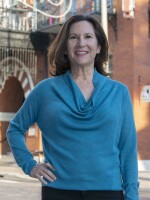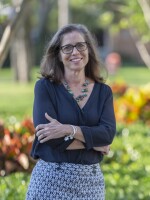Last week we shined a light on the historic neighborhood Progress Village and this week on Florida Matters its story continues.
In the second half of our special two-part series Telling Tampa Bay Stories: Progress Village we hear more residents of Tampa's first affordable housing suburb share their memories growing up there, and talk about how the neighborhood has changed.
In Case You Missed It: Part 1
If you haven’t heard the first part of our series, click here and do so! There are more fascinating stories about Progress Village, mostly from the perspective of some of the neighborhood’s founding residents. There are also old photos from the early days of the village.
We learn in Part 1 that Progress Village was founded in 1960 as a community where African Americans could purchase affordable suburban homes. When residents first moved to the neighborhood there were no street lights, no bus service, no postal service, etc. – that is, until residents formed the Progress Village Civic Council. That organization played a major role in the neighborhood’s development.
As the physical landscape of Progress Village flourished, so did the strong sense of community shared by the people who called it home. Residents were more like brothers and sisters than people who happened to live on the same block.
We also learned that Progress Village has seen a bit of a decline in recent years. Residents suggest the younger generation seems to lack some of the pride in the community the elders have, and development in the areas surrounding Progress Village is threatening to encroach on the neighborhood.
We hear more about that in this week’s show. But we also hear from people of all ages, i.e. teachers, coaches, church leaders, etc. who are still out there working hard to make the neighborhood the best it can be.
Meet Our Storytellers
Linda Washington: Washington has been President of the Progress Village Civic Council since 2011. She grew up in the village and moved away for a time when she got married, but the neighborhood’s family-like atmosphere eventually brought her back home.
“In Bloomingdale I never felt I had neighbors that we could just hang out or do activities with. But in Progress Village you felt that family, you felt that closeness, and that’s what I wanted for my daughter because by the time my daughter was old enough to go to Progress Village Middle Magnet School [of the Arts], she was walking to school. It just felt good to know I had eyes and ears out there.”
Linda’s story was produced by Stephanie Colombini with the help of USF student journalist Ashley Vedral.
Alfred Sheffield: Sheffield is another resident who grew up in Progress Village, left as a young adult and eventually came back to his roots. He paints a vivid picture of what the neighborhood looked like in the early 1960’s, when the only street lights around were lightening bugs, and laments how the village has changed.
“At that time when we moved in, even with segregation, blacks could get very good jobs in Tampa…They could educate their kids properly, raise them, clothe them, feed them and encourage them to make something out of their lives. However through the years so many people have run into very hard economic times…So the neighborhood took a hit.”
Alfred’s story was produced by Stephanie Colombini with the help of USF student journalist Samantha Nieto.
Jackie Davis Mix: Davis Mix is a proud member of the First Baptist Church of Progress Village, one of several churches that have long played a vital role in the community. She talks about how her church has grown since its humble beginnings in 1965 to the present.
“The thing that I most remember that just kind of stays with me is as a child, you could always hear on Sunday morning when it was time for church, they’d ring the church bell so there was a toll around the community to know that church was getting ready to start. And that’s a very memorable thing because we no longer have the steeples on the church, we know longer hear the bell tolling.”
Jackie’s story was produced by Stephanie Colombini with the help of USF student journalist Abby Rinaldi.
Shirley Griffin: Griffin moved to the village kicking and screaming when her husband got stationed in Tampa at MacDill Air Force Base. But after getting involved in the community and taking a job at the local elementary school, she fell in love with the village she still calls home.
“I see them [my former students] all the time – some of them hug me and some of them I just don’t remember!...Some of them went the right way, some of them went the wrong way. But I taught them that in life you have to reason with yourself; you have to follow the good people, the good example of the good people. That’s my motto.”
Shirley’s story was produced by Stephanie Colombini with the help of USF student journalist Tyrah Walker.
Sharon Seabrooks: Seabrooks always wanted to work in Progress Village and her dream came true when she was offered a job as a school counselor in the neighborhood. She’s proud of the many successful graduates that have come out of Progress Village Middle Magnet School of the Arts.
“It takes a village to raise a child, and one thing about Progress Village is they got the name right…Your roots are here in Progress Village…I know people came from all different parts of the United States to come and live in the village but as a village they stick together. They’re strong. They’re people who care enough to know that, ‘Hey, as a neighbor, I’m here for you.’”
Sharon’s story was produced by Stephanie Colombini with the help of USF student journalist Tea Piro.
Bianco and London Berry: This father and daughter are active members of Progress Village Little League. They talk about what they love about the sports program and what it means to have each other’s backs.
Bianco: “One thing I always tell my daughter is you’ve got to trust in your ability…if you work your hardest, you know I’ll never be mad at you for that, so I just want you to go out and give 110% all the time.”
London: “Many people don’t have a dad that can just tell them that, ‘You’re amazing,’ or ‘You’re worth it in life,” so I just feel respected that I have someone who is there for me and can tell me that.”
Bianco and London’s story was produced by Stephanie Colombini with the help of USF student journalist Katherine Ebner and WUSF News Director Mary Shedden.
Ardra Daniels: Daniels has lived in Progress Village close to 30 years, and both she and her husband work in the community. She shares her concerns about how the neighborhood has changed in recent years.
“When I see a lot of the new construction taking place around Progress Village, it concerns me. When the dairy cattle left us right off of 78th St. and now we know that over 1,500 new single-family homes are going in…it concerns me. I think after a while a lot of these private companies will start selling out as well and the village might not be what we used to know it as.”
Ardra’s story was produced by Stephanie Colombini with the help of USF student journalist Justin Garcia.
About The Project
Telling Tampa Bay Stories: Progress Village is a collaboration with journalism students at the University of South Florida’s Zimmerman School of Advertising and Mass Communications. Together we hosted two interview sessions in Progress Village at the Emmanuel P. Johnson Community Center to collect the stories featured in this two-part series.
Special thanks to all those who shared their stories with us both on and off the air, and thanks to the employees at the Emmanuel P. Johnson Community Center for helping facilitate our interview sessions.
WUSF News Director Mary Shedden, USF journalism instructor Jeanette Abrahamsen and WUSF reporter Daylina Miller were also critical participants in this series.







